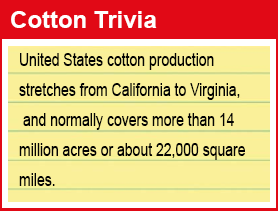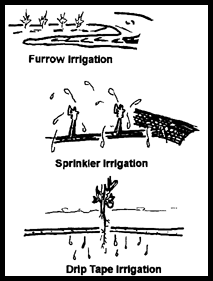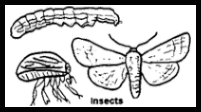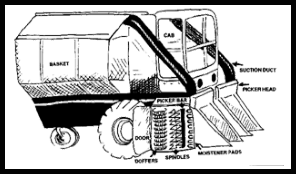The Story of Cotton – Production
Before cotton can be processed into the many products it becomes. It must be planted, irrigated, nurtured with fertilizer, protected from
unwanted weeds, grasses and insects and harvested. This usually means loosening the soil to the depth of 1 to 2 ½ feet with tillage equipment. This will allow water and cotton roots to penetrate the soil and support the plant.
 A seedbed (the row in which the cotton seed will be planted) is prepared by listing (forming land into ridges and furrow) the soil. This allows for faster warming of the soil in the spring and directs irrigation water across the field. Small amounts of soil enriching nutrients, such as nitrogen, phosphorus, potassium, may be added to the soil at this time.
A seedbed (the row in which the cotton seed will be planted) is prepared by listing (forming land into ridges and furrow) the soil. This allows for faster warming of the soil in the spring and directs irrigation water across the field. Small amounts of soil enriching nutrients, such as nitrogen, phosphorus, potassium, may be added to the soil at this time.
Planting may be done by hand, but in the more advanced regions of the world, mechanical planters are used.
When the soil reaches optimum temperature, about 65 degrees, these implements will place the seeds in the soil, usually 1 to 2 inches deep, depending on soil type. The mechanical planters can cover as many as 12 rows at a time.
In some cotton production regions, where soil erosion is a problem, conservation tillage is used. In this system, crop residue from the previous crop or a cover crop is left on the soil surface to protect the soil from heavy rains and winds. A special planter is used to open the soil and place the seed without disturbing the protective cover.
 As the plants demand it, when available, additional water is delivered to the fields. Sometimes only from natural rainfall, called rain-feed farming, or through irrigation (water application through artificial means), called irrigated farming. This can be accomplished in 3 different ways; 1) furrow irrigation takes place by simply running water down a seedbed furrow, 2) sprinkler irrigation is much like lawn sprinklers where pressurized water is sprayed out over an area, and 3) drip tape irrigation, this is a relatively new method of irrigation using buried tubing that releases water into the soil beneath the plant.
As the plants demand it, when available, additional water is delivered to the fields. Sometimes only from natural rainfall, called rain-feed farming, or through irrigation (water application through artificial means), called irrigated farming. This can be accomplished in 3 different ways; 1) furrow irrigation takes place by simply running water down a seedbed furrow, 2) sprinkler irrigation is much like lawn sprinklers where pressurized water is sprayed out over an area, and 3) drip tape irrigation, this is a relatively new method of irrigation using buried tubing that releases water into the soil beneath the plant.
Most of today’s commercial cotton farms use a combination of weed control methods. Such as, Cultivation which is done mechanically by machines called cultivators, hand rogueing or weed removal by people with the use of weed hoes and the application of chemical herbicides (chemicals used to control weeds). Chemical herbicides can be applied before or after the cotton is planted. Once the cotton plant has emerged, cultivation and hand rogueing must be done very carefully in order to kill the weeds but not harm the growing cotton plant. If the weeds were allowed to grow, they would compete for nutrients in the soil that are necessary for a healthy and productive cotton plant.
When the cotton plant is in it’s seedling stage, it is very susceptible to soil borne fungal disease. There are several diseases that can stunt the growth of the plant, cause leaves to fall off, attack the roots and make the plant wither and die. If the effects of disease don’t kill the plant, low yields and a poor quality cotton will result. Development of disease resistant cotton seed has become a priority in the industry. Cotton varieties resistant to some fungi and other destructive organisms have been developed and are being used in certain areas. There is still more research to be done before fungal disease is no longer a factor in producing cotton.
The plant’s food, or nutrients, are referred to in agriculture as fertilizer. Nitrogen, phosphorus, potassium, sulfur, calcium and magnesium are the primary fertilizer elements (macronutrients) but there are several trace elements (micronutrients required in small quantities for optimum plant growth) also. These include copper, manganese, zinc, molybdenum, boron, chlorine and cobalt. Starter fertilizer is usually added to the soil before the seed is planted to provide nutrients to feed a healthy seedling. As the cotton plant grows, its nutrient requirement is monitored and any additions needed are applied.
Insect pests have plagued the cotton growing industry over the years and they are a source of constant concern to growers. Insects such as aphid, mite, bollworms, boll weevil, lygus, thrip, white fly, and pink bollworms cause serious destruction to the cotton plants’ squares, bolls, leaves, and fiber resulting in a monetary loss to the cotton grower. The pink bollworm is responsible for the most cotton damage and has been found in all of the cotton producing countries, including the United States. The spread of this pest is being held in check by plowing cotton stalks under more than 6 inches deep immediately after harvest to remove over-wintering habitat. There are also beneficial insects or predator insects that feed on various insect pests. Most growers use the services of a crop consultant to monitor their fields for insect pest populations and advise them on treatment. If the insect pest population increases to a level that may severely affect the field’s production potential, the grower may then be advised to use an insecticide (a chemical product used to suppress or eliminate an insect pest). These products may be applied by a ground application vehicle specially designed to avoid damaging the cotton plants. Airplanes and/or helicopters are used for air applications, flown low over the field by trained pilots to deliver their load.
 A method of insect pest control being practiced on a limited basis is called integrated pest management (I.P.M.). This method coordinates the use of insecticides and the dispersal of beneficial insects purchased to aid in suppressing unwanted insects. Research is being done to find insects to control a wider spectrum of insect pests, a limiting factor of effectiveness in today’s I.P.M. practices.
A method of insect pest control being practiced on a limited basis is called integrated pest management (I.P.M.). This method coordinates the use of insecticides and the dispersal of beneficial insects purchased to aid in suppressing unwanted insects. Research is being done to find insects to control a wider spectrum of insect pests, a limiting factor of effectiveness in today’s I.P.M. practices.
Pest management in cotton production today contributes a substantial share of the costs involved in raising a crop. The cotton farmer is reluctant to treat weed and insect pests unless absolutely necessary to protect crop yield potential. The correct decisions and timing of both irrigations and pest control measures is an ally to a grower’s success as he/she guides their crop to maturity.
When enough bolls have opened naturally, harvest aids are applied to the plant to help speed up the maturation process. This, also, is done either by ground or air application. Defoliation helps the leaves to dry and fall off and to help any of the remaining unopened cotton bolls to open. This practice enables the grower to hasten the opening of the cotton bolls which can then be gathered quickly, in a short period of time. It is essential that the crop is harvested before weather and rain can damage or ruin its quality and reduce yield. Frost also causes the plant to shed its leaves naturally and assists in splitting bolls, but may occur too late in the season to benefit harvest. Now the cotton crop is ready to be harvested.
 For centuries cotton has been picked by hand. Hand picking is done in the less progressive cotton growing regions of the world. It is very inefficient and no longer practiced in modernized countries.
For centuries cotton has been picked by hand. Hand picking is done in the less progressive cotton growing regions of the world. It is very inefficient and no longer practiced in modernized countries.
As the mechanical cotton picker moves through the field, the cotton plants are guided through the picker head (a unit that contains the picking components). The seed cotton, or locks, in the bur encounter revolving barbed spindles attached to a picking bar (a vertical bar that contains 18 to 20 spindles) attached to a rotating drum. The locks are grabbed by the barbed spindle and pulled from its bur. The rotating drum then moves the picking bar toward the doffer. A doffer is a series of curricular, rubber lined pads, stacked 18 to 20 high, that remove cotton from the spindle. The seed cotton and spindles pass through the doffer where the cotton is removed or doffed from the spindle to fall to the picker door (a side component of the picker with channeling to facilitate the movement of cotton). An air vacuum created by a fan then sucks the cotton away from the door and blows it into the basket. The spindle now continues on its rotation passing through the moistener pads (small finned pads stacked 18 to 20 high, which add water and/or moistening agent to the spindles) where they are lubricated to assist in cleaning them. This sequence repeats itself continually while the cotton is being picked. Spindle type cotton pickers harvest most of the cotton grown in the United States.
In some areas of the Cotton Belt, brush strippers are used to harvest seed cotton. These machines remove bolls and burs from the plant with rotating brushes and bats. Material is fed into a field cleaner where much of the burs and sticks are removed and blown into a large basket. They are used primarily in dryland farming cotton areas in Texas where the cotton plant varieties are more compact in stature. Small plant size is important when using a stripper because they tend to accumulate more trash (leaves, bolls, stems and branches) in their harvested product.
Today’s modern cotton harvesters can cover up to 6 to 8 rows at a time and can harvest up to 190,000 pounds of seed cotton a day. These new cotton harvesters are a major improvement over the hand methods of the past.
 Prior to the development of the module builder, most cotton picked by machines was dumped into cotton trailers and hauled to a cotton gin (a place where seed and fiber are mechanically separated). This system became inefficient when the trailers were filled faster than the gin could process the cotton and the cotton pickers had to cease harvesting while waiting for trailers to empty. This challenge was met with the invention of the module builder in 1972. This implement allows cotton to be dumped from the picker onto the ground and be compressed hydraulically to form a module (tightly pressed stack) of cotton. Each module holds 12-14 bales. This module can be left in the field for storage and later be hauled directly to the gin or transported by a module mover to the gin’s storage yard. The use of these builders allow the pickers to continue harvesting, unimpeded by ginning problems or delays.
Prior to the development of the module builder, most cotton picked by machines was dumped into cotton trailers and hauled to a cotton gin (a place where seed and fiber are mechanically separated). This system became inefficient when the trailers were filled faster than the gin could process the cotton and the cotton pickers had to cease harvesting while waiting for trailers to empty. This challenge was met with the invention of the module builder in 1972. This implement allows cotton to be dumped from the picker onto the ground and be compressed hydraulically to form a module (tightly pressed stack) of cotton. Each module holds 12-14 bales. This module can be left in the field for storage and later be hauled directly to the gin or transported by a module mover to the gin’s storage yard. The use of these builders allow the pickers to continue harvesting, unimpeded by ginning problems or delays.
 We have done all the research for you…gathered supplemental literature books, videos and CD’s, and offer a variety of resources to be used in conjunction with your study unit. So let’s get started on our cotton’s journey and learn more about this useful, resourceful and magical plant we take for granted…COTTON!
We have done all the research for you…gathered supplemental literature books, videos and CD’s, and offer a variety of resources to be used in conjunction with your study unit. So let’s get started on our cotton’s journey and learn more about this useful, resourceful and magical plant we take for granted…COTTON! ![]()

